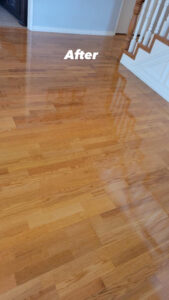 For centuries, wax has been the go-to choice for protecting and beautifying wood floors. However, in recent years, sealers have emerged as a superior alternative, offering several advantages over traditional waxes.
For centuries, wax has been the go-to choice for protecting and beautifying wood floors. However, in recent years, sealers have emerged as a superior alternative, offering several advantages over traditional waxes.
Enhanced Durability and Protection:
- Sealers penetrate deeper into the wood, creating a stronger barrier against scratches, scuffs, and everyday wear and tear.
- Waxes typically sit on the surface, offering less robust protection and being more susceptible to damage.
Superior Moisture Resistance:
- Sealers form a tighter bond with the wood, effectively repelling water and preventing warping, cracking, and mildew growth.
- Wax provides some moisture resistance, but its surface-level protection can be easily compromised by spills and humidity.
Long-lasting Beauty:
- Sealers come in a variety of finishes, from matte to satin to gloss, allowing you to achieve your desired aesthetic.
- Waxes tend to offer a high-gloss finish only, which can show scratches and imperfections more readily. Additionally, waxes can yellow over time, dulling the natural beauty of the wood.
Easier Maintenance:
- Sealed floors are easier to clean and maintain. They require only regular sweeping, mopping with a suitable wood floor cleaner, and occasional buffing.
- Waxed floors often need more frequent reapplication, and the removal of built-up wax layers can be a time-consuming and laborious process.
Safety Considerations:
- Waxes can make floors slippery, especially when wet, increasing the risk of slips and falls.
- Sealers, on the other hand, provide better traction, making them a safer choice for homes with children and pets.
Choosing the Right Sealer:
With a wide variety of sealers available, it’s crucial to choose one formulated for your specific type of wood floor and desired finish. Consult with a professional or refer to the manufacturer’s recommendations for optimal results.
By making the switch from wax to sealer, you can ensure your wood floors stay beautiful, protected, and easy to maintain for years to come.
